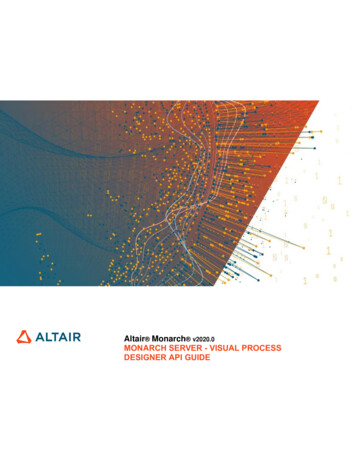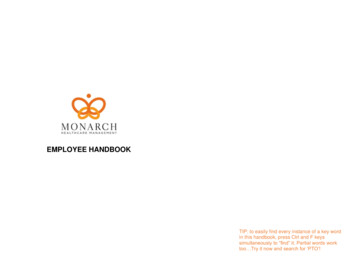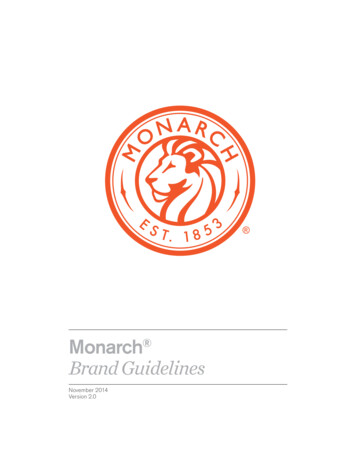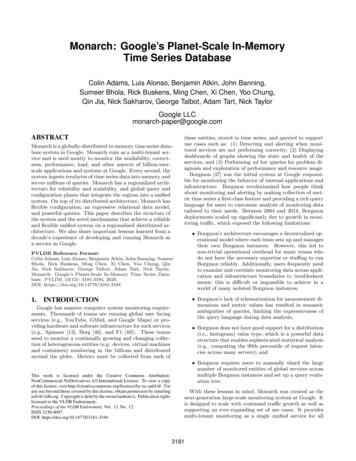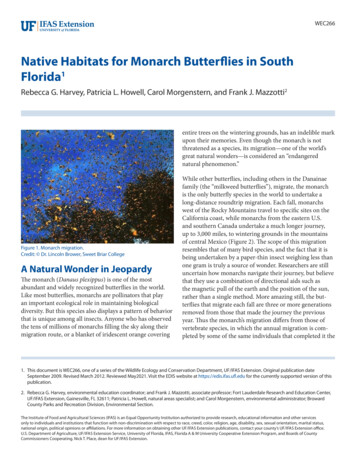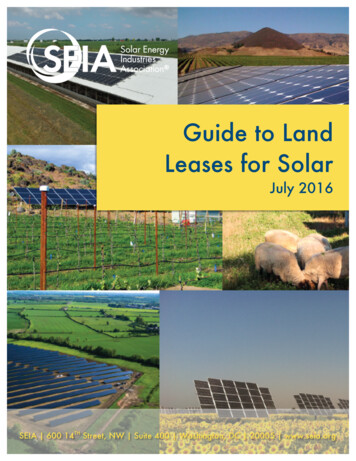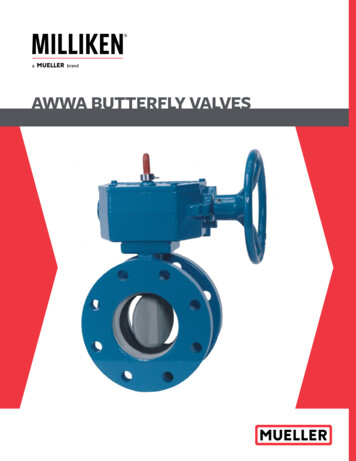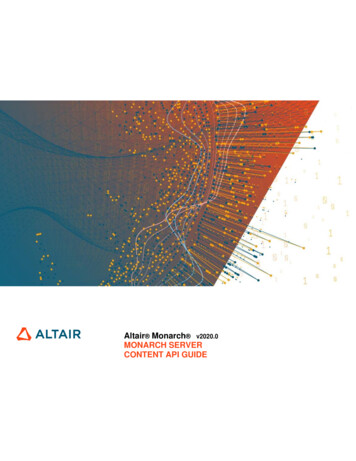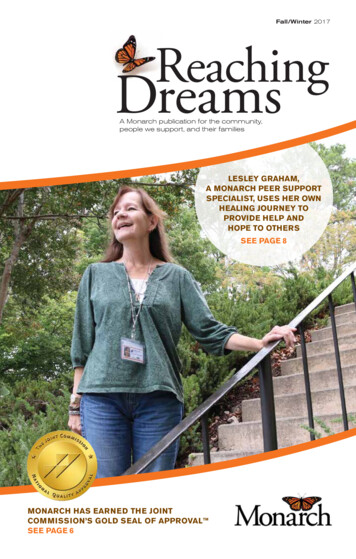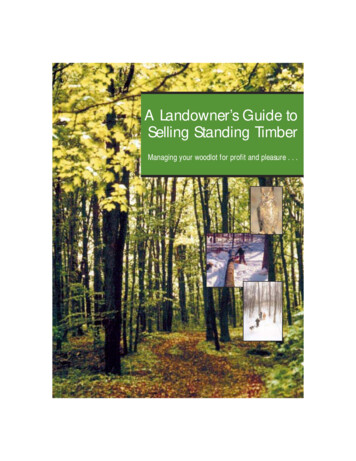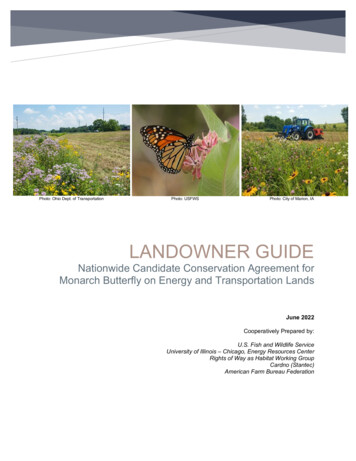
Transcription
Photo: Ohio Dept. of TransportationPhoto: USFWSPhoto: City of Marion, IALANDOWNER GUIDENationwide Candidate Conservation Agreement forMonarch Butterfly on Energy and Transportation LandsJune 2022Cooperatively Prepared by:U.S. Fish and Wildlife ServiceUniversity of Illinois – Chicago, Energy Resources CenterRights of Way as Habitat Working GroupCardno (Stantec)American Farm Bureau Federation
Landowner GuideNationwide Candidate Conservation Agreement for Monarch Butterfly on Energy and Transportation LandsTable of Contents1.What is the Monarch CCAA? . 1-21.11.21.31.4Why is monarch conservation important? . 1-2What do monarchs need? . 1-2How does the CCAA work? . 1-3What is the Landowner Buffer Provision? . 1-3Speaking the language of the Monarch CCAA (Terminology) . 2-4Landowners and the Monarch CCAA . 3-63.13.2What does the CCAA mean for landowners with property along rights-of-way? . 3-6CCAA Measures on Fee-Title Lands vs. Easements . 3-6Working Together on Conservation. 3-6As a landowner, do I need to do anything with the CCAA? . 3-7Take no action . 3-7Self-certify your monarch habitat work under the optional buffer provision . 3-7Landowner Buffer Provision Process . 4-7Monarch Conservation Tips for Landowners . 5-115.15.25.35.4Common landowners along energy and transportation lands . 5-11Recommended conservation actions for landowners . 5-11Online resources for landowners. 5-11For Agricultural Producers:. 5-11For Non-Agricultural Landowners:. 5-12Community Science Participation:. 5-12Conservation Partnerships: . 5-13CCAA-focused conservation measures . 5-13Who to Contact for More Information . 6-1Appendix A. CCAA Conservation Measures for Monarch Butterflies. iJune 2022What is the Monarch CCAA? 1-1
Landowner GuideNationwide Candidate Conservation Agreement for Monarch Butterfly on Energy and Transportation LandsWhat is the Monarch CCAA?The Nationwide Candidate Conservation Agreement with Assurances for Monarch Butterflies on Energyand Transportation Lands (CCAA) was developed by energy companies and transportation agencies withthe U.S. Fish and Wildlife Service and the Energy Resources Center at the University of Illinois Chicago.The CCAA provides regulatory certainty for energy companies’ and transportation agencies’ ongoingactivities and supports monarch conservation. Long-term success of this agreement is best accomplishedthrough cooperation between landowners and easement holders enrolled in the CCAA.The CCAA is the first, nationwide conservation agreement of its kind. Energy companies andtransportation agencies participating in this agreement make an important contribution to conservation by: Creating and sustaining much-needed habitat for the iconic monarch butterfly, Supporting a national framework for large-scale conservation across two major industries, Being an example for other conservation agreements to address other species at-risk.1.1Why is monarch conservation important?Monarch butterfly (Danaus plexippus) populations are in decline across their range in North America. Thebutterfly, associated with milkweeds and meadows across the country, has eastern and westernpopulations generally separated by the Rocky Mountains (in addition to a small, non-migratory populationin Florida). Both have experienced declines since modern surveying and recordkeeping began in the mid1990s. In its 2020 Species Status Assessment Report, the U.S. Fish and Wildlife Service (Service)calculated that, given recent trends in species decline and habitat degradation and loss, the probability oflosing the eastern population over the next 60 years is 61%, with near 99% probability for the westernpopulation (USFWS 2020). Due to recent declines and a petition to list the monarch, the Serviceassessed the species for potential listing as Federally Threatened or Endangered. In December of 2020,the Service determined that listing the monarch under the Endangered Species Act is warranted but thatthe species would not be proposed for listing at that time due to higher priority listing actions that theService is working on. The Service will reevaluate the monarch’s status annually until a final listingdecision is proposed in 2024.1.2What do monarchs need?Monarchs rely solely on a group of plants commonly referred to as milkweeds, primarily those species inthe genus Asclepias. They lay eggs on milkweeds and then the larvae feed exclusively on these plantsuntil they pupate and emerge as adult butterflies. As adults, monarchs will feed on a variety of floweringplant species and require nectar sources throughout the growing season. Therefore, a diverse array ofwildflowers is necessary to support a healthy monarch population, including species that flower during theearly, mid, and late summer, and fall.General lack of habitat and habitat degradation are important factors in monarch decline. Habitatconnectivity plays a role in monarch health. Habitat connectivity may be improved by simply increasingthe acreage of land supporting milkweed and other native wildflowers, and by restoring corridors ofnaturally vegetated green spaces that allow for species migration and movement. These corridors providethe opportunity for flight when one area becomes less suitable for monarch survival. During spring and fallmigration, monarchs may have to fly significant distances over inhospitable terrain, including urban andindustrial areas and those dominated by row crop agriculture. Increasing availability of foraging andstopover habitat will better support the species and their seasonal migration.June 2022What is the Monarch CCAA? 1-2
Landowner GuideNationwide Candidate Conservation Agreement for Monarch Butterfly on Energy and Transportation Lands1.3How does the CCAA work?The CCAA is a voluntary agreement that promotes conservation to benefit monarch butterflies. Energycompanies and transportation agencies may enroll as Partners and by committing to take beneficialactions for monarch butterflies, they receive clarity and certainty on future regulatory requirements relatedto the monarch. The Enhancement of Survival Permit, issued by U.S. Fish and Wildlife Service along withthe CCAA, allows enrolled energy companies and transportation agencies to perform routine operationsand maintenance work on lands they own and manage without additional Endangered Species Actregulatory requirements associated with monarch butterflies.The CCAA program is administered by the Energy Resources Center at the University of Illinois Chicago.In order to enroll, Partners must submit an application that details their conservation actions and commitsthem to meeting minimum conservation targets for the lands they own and manage, monitoring thehabitat conditions on a regular basis, and then tracking and reporting their benefits to monarch butterflieson areas where practices are “adopted.”Recognizing that their rights-of-way and other managed lands could provide suitable habitat, dozens oforganizations have enrolled in the CCAA to date. Participation in the CCAA demonstrates that energycompanies and transportation agencies are having a net benefit to monarch butterflies across the landsthey own and manage. Collectively, these actions make a meaningful contribution to providing monarchbutterfly habitat throughout the continental United States.1.4What is the Landowner Buffer Provision?The Enhancement of Survival Permit associated with the CCAA provides incidental take coverage for theenergy companies and transportation agencies that have committed to undertaking conservation formonarch butterflies. Incidental take coverage can help limit participant liability for certain practices thatmay impact the monarch butterfly and provide participants with regulatory assurances that no additionalpractices will be required of them in the event that the monarch butterfly becomes listed as a threatenedor endangered species. As a way to encourage landowner cooperation with enrolled Partners, that samepermit includes a “landowner buffer provision” that extends the same incidental take coverage tolandowners with lands located within 100-feet of “adopted acres.” This provision offers incidental takecoverage to landowners provided that:1. Monarch conservation measures identified in the CCAA (and this guide) are implemented andcan be documented by landowners (or their designees) within the 100-foot buffer zone,2. The incidental take by the landowners (or their designees) results from the implementation ofthese conservation measures or from covered activities (including the landowner's generaloperations, maintenance and modernization, or vegetation management activities), and3. The activities will not result in take of listed or proposed species other than monarch butterfly, willnot destroy or adversely modify designated or proposed critical habitat of any listed species, andwill not affect historic properties. If unsure whether an activity may cause take, contact your localUSFWS Field Office with questions.More information about the Landowner Buffer Provision is provided in Sections 3 and 5 below.June 2022What is the Monarch CCAA? 1-3
Landowner GuideNationwide Candidate Conservation Agreement for Monarch Butterfly on Energy and Transportation LandsSpeaking the language of the Monarch CCAA(Terminology)The CCAA uses unique words to describe aspects of the agreement and participation. Here is a brief listof terms commonly used in the CCAA. These terms have been condensed from their full descriptionincluded in the original CCAA (pdf).Adopted Acres: Area within a managed rights-of-way on which conservation measures are applied tosupport monarch butterfly habitat. Adopted acres are a subset of a Partner’s enrolled lands.CCAA (Candidate Conservation Agreement with Assurances): Voluntary conservation agreementsbetween the Service and one or more non-Federal property owners or managers. Property owners ormanagers commit to implement mutually agreed-upon measures to support a species in conservationneed. In return, the property owners receive assurances from the Service that additional requirements willnot be imposed upon them should the species become listed in the future. For this particular Agreement,non-Federal property owners and managers are referred to as “Partners.”Certificate of Inclusion: A certificate documenting the Partner’s voluntary agreement to enroll specifiedproperty in the CCAA. Certificates of Inclusion document the Partner commitment to the CCAA terms andconveys the permit applicability to enrolled land.Conservation Measures: Measures that aim to conserve and enhance the survival of the monarchbutterfly and its habitat by addressing identified key threats identified by the U.S. Fish and WildlifeService. All conservation measures are conducted in accordance with existing permits, easements, andagreements that allow the Partners to access and manage their enrolled lands. Conservation measuresdo not include actions that pose significant environmental, socioeconomic, historic, or cultural impacts.Within the CCAA, conservation measures include actions like: Mowing at times of year when monarchsare not present Removing brush and woody plants Herbicide treatments that target aspecific plant or group of plants andavoids contacting off-target vegetation Prescribed grazing or burning Seeding or planting flowering nectarplants Letting habitat grow as “idle lands”Covered Activities: Land management, maintenance, and modernization activities on enrolled lands thatare reasonably certain to cause take of monarchs. This may include, but is not limited to, broadcastapplication of herbicides or mowing in areas of suitable monarch habitat, or other vegetation managementthat may be incompatible with the maintenance of monarch habitat. New construction is not a coveredactivity. If the monarch is listed as endangered or threatened under the Endangered Species Act,incidental take of monarchs that occurs as a result of covered activities carried out by a Partner who isadhering to the terms of the Certificate of Inclusion or a landowner who is adhering to the terms of theLandowner Buffer Provision, will be authorized under the EOS Permit. See Section 5 in the CCAA foradditional detail and examples of covered activities.Enhancement of Survival Permit (EOS Permit): If the monarch is listed, the EOS Permit will provideincidental take authority for covered activities of Partners enrolled under the Agreement through aCertificate of Inclusion, or stated permit provisions. This permit is issued pursuant to Section 10(a)(1)(A)of the Endangered Species Act. The Permit becomes effective upon any final rule listing the monarch, ifor when applicable. The Landowner Buffer Provision is described within the EOS Permit.June 2022Speaking the language of the Monarch CCAA (Terminology) 2-4
Landowner GuideNationwide Candidate Conservation Agreement for Monarch Butterfly on Energy and Transportation LandsEnrolled Lands: The lands (either owned, leased, permitted, or managed easements) included by anenergy company or transportation agency in their Certificate of Inclusion. Eligible lands for enrollmentinclude any properties, leases, and easements where the company or agency may conduct work.Adopted acres are a subset of a Partner’s enrolled lands.Harass: To intentionally or negligently, through act or omission, create the likelihood of injury to wildlife byannoying it to such an extent as to significantly disrupt normal behavior patterns such as breeding,feeding, and sheltering.Harm: To perform an act that kills or injures wildlife; may include significant habitat modification ordegradation when it kills or injures wildlife by significantly impairing essential behavioral patterns includingbreeding, feeding, or sheltering.Historic Property: Any prehistoric or historic district, site, building, structure, or object included on, oreligible for inclusion on, the National Register of Historic Places, including artifacts, records, and materialremains related to such a property or resource. For the purposes of the buffer provision, historic propertyalso includes sites considered as traditional cultural properties.Incidental Take: The term "take" means to harass, harm, pursue, hunt, shoot, wound, kill, trap, capture,or collect, any threatened or endangered species, or to attempt to do the same. 16 U.S.C. § 1532(19). An"incidental take" refers to a taking that results from, but is not the purpose of, carrying out an otherwiselawful activity. 50 C.F.R. § 402.02. To determine whether or not federally threatened or endangeredspecies may be present, an ‘official species list’ may be obtained from the USFWS.Incompatible Vegetation: The Utility Arborist Association’s Integrated Vegetation Management BestManagement Practices Manual defines incompatible vegetation as any plant that is inconsistent withintended use of a site. Within rights-of-way, this typically includes plants that have undesirable effects onsafety, security, access, fire risk, utility service reliability, wildlife habitat, pollinator forage, emergencyrestoration, visibility, line-of-sight requirements, regulatory compliance, the environment, or otherconcerns.Landowner Buffer Provision: A condition under the EOS Permit that extends incidental take coveragefor monarch butterflies by landowners that manage land on, or within 100-feet of, adopted acrescommitted under the CCAA. In order to qualify, landowners must be supporting monarch habitat. Otherconditions apply. The full description of the provision can be found in Section VI of the EOS Permit titledBuffer Zone Activities.Official Species List: An official letter from the local USFWS office containing information to assist you inevaluating the potential presence of federally listed and proposed species in a defined area. It includes alist of species and critical habitat that should be considered when evaluating the potential impacts of aproject.Partners: Companies, agencies, and other organizations working in the energy or transportation sectorsthat are landowners or manage vegetation through an easement, permit, or other access andmanagement type agreement, who voluntarily agree to the terms and conditions described in the CCAAand their Certificate of Inclusion in it.Program Administrator: The organization that holds the EOS Permit issued by, and subject to, USFWSoversight. The University of Illinois Chicago operates as the Program Administrator for the CCAA.Suitable Habitat (for monarch butterflies): Lands that provide either milkweed and/or potentially floweringnectar plants which support monarch breeding or foraging needs at times of the year when monarchs arepresent.Speaking the language of the Monarch CCAA (Terminology) 2-5
Landowner GuideNationwide Candidate Conservation Agreement for Monarch Butterfly on Energy and Transportation LandsLandowners and the Monarch CCAA3.1What does the CCAA mean for landowners with property along rightsof-way?Rights-of-way managers (referred to as “Partners” to the CCAA) may enroll fee-title owned lands(company/agency-owned lands) and lands on which the Partner maintains leases, easements or otheragreements that allow conservation measures and/or covered activities described in the CCAA. The landownership and management rights attributed to the Partner dictates what they can or cannot do in termsof monarch conservation.CCAA Measures on Fee-Title Lands vs. EasementsPartners enrolling fee-title-owned lands retain full control to address identified threats to monarchbutterflies through conservation measures. In contrast, on enrolled easement or leased lands, the Partneris limited only to the property rights allowed through their lease or easement agreements. In theseinstances, landowners retain control of how they manage lands in light of that easement. Eachrelationship on easements between Partners and landowners is unique, dictated by the land-rightsagreement in place for that parcel. The CCAA, or USFWS permit accompanying it, does not change oralter existing land-rights agreements, easements, leases, other agreements or the property rights of thePartner or landowner.Partners’ participation in the CCAA does not change or impact the land use of existing agreements, nordoes it give Partners permission beyond existing agreements without the consent of the landowner. Forexample, the CCAA does not give Partners permission to convert existing pasture, a wildlife food plot,cropland, golf course, or maintained yard into monarch habitat.Working Together on ConservationPartners may elect to alter vegetation management to minimize threats to monarch butterflies on a portionof enrolled lands (these areas are referred to as “adopted acres”). Examples of altered vegetationmanagement include mowing less often or at a taller height, spot spraying incompatible vegetation orinvasive species instead of widespread herbicide use, and mechanically removing incompatiblevegetation. A list of monarch conservation measures aligned with the CCAA is summarized in Appendix Ato this guide.Partners enrolling easements within the CCAA agree to obtain consent from landowners before takingany actions outside the scope of existing easement agreements. When implementing conservationmeasures on easements or leased lands, the Partner is limited to only those activities allowed under theeasement/lease or must obtain additional consent from the underlying landowner as outlined below. Where conservation measures coincide with activities authorized under existing leases,easements or other land-rights agreements, the Partner will follow its organization’s applicableprocedures regarding landowner notification or consent and conduct activities only within theallowable scope. Where conservation measures do not coincide with easement or lease authority, the Partner willeither a) not conduct the activity beyond the allowable scope, or b) obtain the required consent orauthorization from the underlying landowner prior to conducting the activity. Partners will obtain consent or authorization from the underlying landowner before intentionallyseeding or planting native plants on active cropland specifically for the purpose of creatingmonarch habitat. Monitoring plants and habitat in areas where vegetation management is done in a manner tosupport monarch butterflies is part of the CCAA. This monitoring is conducted once a year, orLandowners and the Monarch CCAA 3-6
Landowner GuideNationwide Candidate Conservation Agreement for Monarch Butterfly on Energy and Transportation Landsless frequently, in randomly selected locations across the adopted acres. Partners will abide byaccess language in existing agreements with landowners when conducting monitoring activities.The enrollment of lands in the CCAA or the buffer provision (described below and in Section 4) does notimpact any existing or future agreements with the U.S Department of Agriculture or the U.S. Fish andWildlife Service, including those for the monarch butterfly.3.2As a landowner, do I need to do anything with the CCAA?If you are a landowner with an energy or transportation rights-of-way located on or adjacent to your land,we encourage you to engage in your own monarch conservation efforts by establishing and/or protectingmilkweed and flowering plants. Section 5 provides additional guidance on how you can help.Under the CCAA, landowners have the ability to “self-certify” their own conservation actions andincidental take coverage under the CCAA permit’s Landowner Buffer Provision (see Section 4 for thespecific procedures). Under this provision, landowners located on or adjacent to an energy ortransportation rights-of-way enrolled in the CCAA can either:Take no actionLandowners are not required to take action or participate in the CCAA. Even if an energy company ortransportation agency enrolls easement or leased lands, the authority in current land-use agreementsremains unchanged.If a landowner opts to take no action, the Partner organization (i.e., energy company or transportationagency) may continue to enroll lands and receive assurances (i.e., regulatory protection). In this situation,the landowner does not receive regulatory protection since they did not seek incidental take coveragethrough their own self-certification process. Landowners will be responsible for ensuring thatincidental take of monarchs does not occur if this species is listed.Self-certify your monarch habitat work under the optional buffer provisionLandowners may self-certify their eligibility for the optional Landowner Buffer Provision in order to receiveincidental take coverage for monarch butterflies within 100 feet of the Partner’s adopted acres. Theprovision is not applicable to buffer lands in row crop agriculture because row crop agriculture is generallyconsidered as not providing habitat (milkweeds and flowering plants) for the monarch butterfly; however, itmay be applicable to pastureland or other non-production areas because these lands may contain naturalvegetation that can include milkweeds or flowering plants that provide nectar for monarchs.Landowners enrolling in the buffer provision must complete a self-certification form online (download,print, sign and retain for your records.). See Section 4 for additional information.Landowner Buffer Provision ProcessWe recommend landowners interested in monarch conservation and who would like permission forincidental take of monarchs on eligible lands under the buffer provision document their conservationefforts following an established self-certification process (Figure 2):1. Landowner confirms they have a rights-of-way (ROW) on, or within 100 feet of, their land byreviewing their own property and easement agreements (Figure 1).Landowner Buffer Provision Process 4-7
Landowner GuideNationwide Candidate Conservation Agreement for Monarch Butterfly on Energy and Transportation LandsFigure 1. Illustration of the buffer zone2. Landowner confirms the ROW entity is enrolled in CCAA by reviewing enrolled Partners website.a. See the CCAA Partners Map. Landowners can click on the map to see a list of CCAAPartners in their state.b. If the ROW entity (utility or highway department) on, or within 100 feet of, the property ison the list of Certificates of Inclusion in the landowner’s state, proceed to next question. Ifnot, the ROW entity is not enrolled in the CCAA and the landowner is not eligible forthe buffer zone coverage.3. Landowner determines if they likely have CCAA adopted acres on or within 100 feet of theirproperty. How does a landowner know if they have an adopted acre on or within 100 feet of theirproperty? Confirm the following:a. Do you have natural vegetation within your utility/road easement?i.Natural or semi-natural vegetation means any-non-agricultural, native, ornaturalized plants that are allowed to grow on their own. It generally includesgrasses, wildflowers, trees, shrubs, and vines, and does not include cultivatedplants like lawn grasses or agricultural crops.Under the CCAA, enrolled energy companies and transportation agencies mayadopt conservation measures in natural vegetation that help protect and sustainmilkweeds and other flowering plants as part of their “adopted acres”.b. If yes, the lands within the easement are likely considered adopted acres.c.If no, the lands within the easement area are not likely adopted acres.4. Landowner verifies their alignment with conservation measures (see Appendix A) and coveredactivities (Table 1) in the CCAA and the buffer zone provision of the CCAA permit.a. Do you agree to undertake measures that conserve monarch butterfly habitat within 100feet of the adopted acres within the ROW easement?b. Does your activity avoid "take” of or otherwise impact any other federally listed orproposed threatened or endangered species and/or critical habitats? In other words, doesit not do any of the following: harass, harm, pursue, hunt, shoot, wound, kill, trap, capture,or collect? See the definition of “incidental take” described in Section 2.Landowner Buffer Provision Process 4-8
Landowner GuideNationwide Candidate Conservation Agreement for Monarch Butterfly on Energy and Transportation Landsc.Does your activity within the buffer zone (within 100 feet of natural vegetation oneasements held by CCAA Partners) comply with all other applicable state, local, tribal, orother Federal law?5. If yes to 4a, 4b, and 4c, you are eligible for coverage under covered by the landowner bufferprovision in the CCAA EOS Permit. Complete a self-certification form for your records forcoverage.6. If no to 4a, 4b, or 4c, then the buffer provision does not apply.Table 1. Examples of activities that are covered and not covered under the buffer provisionCovered Not CoveredMowingHayingHerbicide useControlled grazingGrading and excavationDriveway or roadside maintenance Insecticide useIntentional harm, harassment, or destructionof monarchsActivities outside of the 100-foot buffer areacovered by the permit.New constructionLandowner Buffer Provision Process 4-9
Landowner GuideNationwide Candidate Conservation Agreement for Monarch Butterfly on Energy and Transportation LandsFigure 2. Graphic depicting the landowner buffer provision process as a flow chart.Landowner Buffer Provision Process 4-10
Landowner GuideNationwide Candidate Conservation Agreement for Monarch Butterfly on Energy and Transportation LandsMonarch Conservation Tips for Landowners5.1Common landowners along energy and transportation landsAll non-federal landowners with lands adjacent to energy and transportation lands may participate in theLandowner Buffer Provision. Examples of landowners who may choose to conserve monarch butterflyhabitat in the buffer zone include, but are not limited to, agricultural producers, homeowners, businesses,non-federal public landowners (e.g., parks), or golf courses. As no single entity is responsible forproviding habitat needed to sustain monarch butterfly populations; a concerted and cooperative effort ofall organizations, agencies and individuals to promote and conserve habitat is required to prevent furtherdeclines of monarch butterflies.Participation in the Landowner Buffer Zone Provision can leverage the positive effects from Partners’efforts through the CC
Monarch conservation measures identified in the CCAA (and this guide) are implemented and can be documented by landowners (or their designees) within the 100- foot buffer zone, 2. The incidental take by the landowners (or their designees) results from the implementation of
